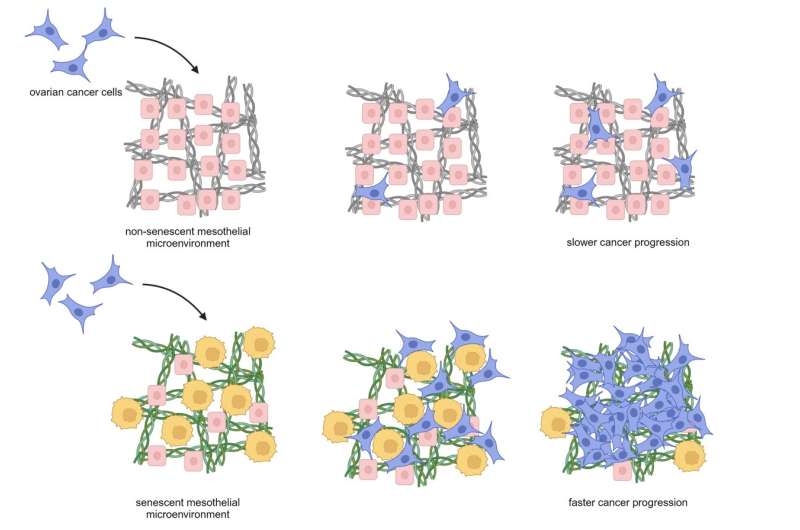This article has been reviewed according to Science X's editorial process and policies. Editors have highlighted the following attributes while ensuring the content's credibility:
fact-checked
peer-reviewed publication
trusted source
proofread
Aging cells may boost ovarian cancer spread, say scientists

Ovarian cancer is dangerous because it often goes undetected until it has spread beyond the ovaries, and the symptoms can also be attributed to other conditions.
Scientists believe that aging can increase the spread of ovarian and other cancers, but the underlying mechanisms are not fully clear. Now, researchers at the Indian Institute of Science (IISc) have found that ovarian cancer cells can spread more easily in tissues that are senescent or aged because these tissues secrete a unique extracellular matrix that attracts the spreading cancer.
The researchers used a chemotherapy-induced senescent model to study this phenomenon. They first extracted tissues found in the lining of body cavities from mice models and exposed half of these tissues to chemotherapeutics that are used to treat cancer, pushing them to senescence—a state in which the cells stop replicating but don't die.
"What you might call in a body aging, in a cell or tissue you would call it senescence," explains Ramray Bhat, Associate Professor at the Department of Developmental Biology and Genetics (DBG) and corresponding author of the study published in Cellular and Molecular Life Sciences.
The team then exposed both young and aged mouse tissues and human tissue-like cell sheets to ovarian cancer cells. They used time-lapse imaging to tag the normal and cancer cells with different fluorescent markers so that they could be studied under a microscope for extended periods of time.
"It's slightly harder to image tissues when compared to cell lines as the latter has only one particular cell type growing," explains Bharat Thapa, first author and former biology undergraduate student at IISc, now pursuing a Ph.D. at Vanderbilt University, U.S.
What they found was that the cancer cells chose to settle down more on the aged tissues; moreover, they settled closer to the aged normal cells in the cell sheets.
To figure out what was drawing the cancer cells to the aged cells, the team first wondered if they were being attracted to signaling molecules that were being secreted by the aged cells and diffusing over long distances. They built computer models to explore the interactions between the cancer cells and the aged cells.
What they found was surprising: It was not the diffusing molecules that were luring the cancer cells. It was proteins secreted by aged cells that settle down as the extracellular matrix (ECM)—the base on which the cells adhere and grow—that were calling the cancer cells. "The extracellular matrix is what was bringing the cancer cells there and allowing them to better attach near the aged cells and spread faster," says Bhat.
The team also carried out experiments on human cell lines to replicate the predictions of the computer simulations. They noticed that the cancer cells stuck strongly to the extracellular matrix around the aged cells, and eventually cleared the aged cells away. They also noticed that the aged ECM had higher levels of proteins such as fibronectin, laminin and hyaluronan compared to the young cells' ECM, which allowed the cancer cells to bind more strongly.
Based on their findings, the researchers suggest that this could potentially be one of the reasons why aged populations typically tend to have worse outcomes in cancer than younger populations. "The fact is that chemotherapy also induces senescence, and that senescence can make things worse," says Bhat. "Appropriate use of chemotherapy could be very important in getting good outcomes in ovarian cancer."
One way forward, adds Bhat, could be to focus on finding probes that can identify some of these matrix proteins, which can help predict where the cancer cells would get deposited in the tissues.
Thapa also hopes that future studies will build a strong case for using senolytics—drugs that kill senescent cells—as a combination therapy with chemotherapeutics to tackle cancer progression.
More information: Bharat Vivan Thapa et al, The senescent mesothelial matrix accentuates colonization by ovarian cancer cells, Cellular and Molecular Life Sciences (2023). DOI: 10.1007/s00018-023-05017-x



















